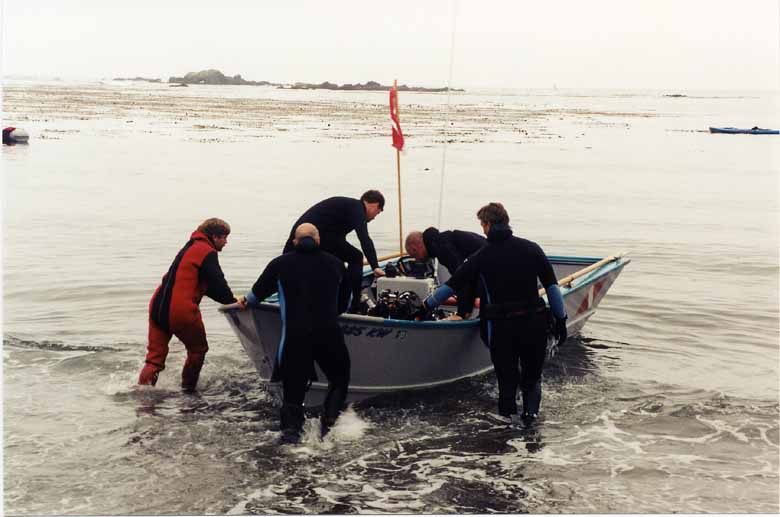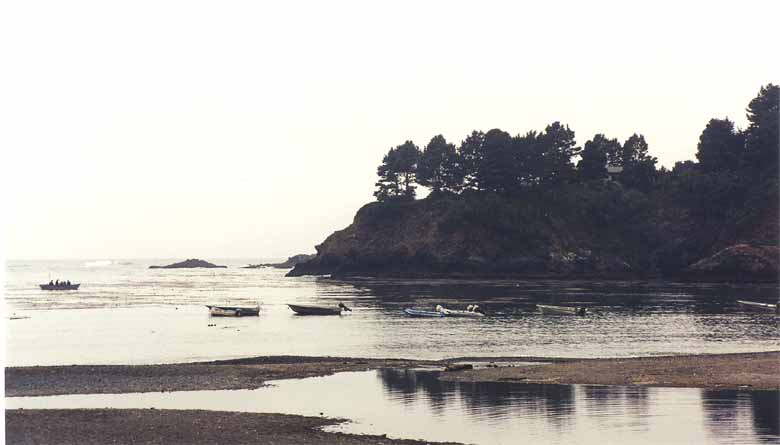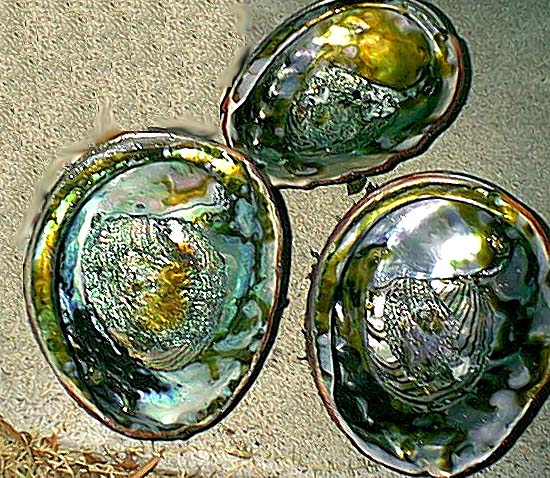Sea Ranch 2002 Dive 2
Abs At Van Damme
North Coast freediving is some of the most challenging
diving in the world. Hunting, lack of boat facilities and exceptional
near shore diving are part of what make it well worth the effort. Waves,
currents, cold, wind and rocks make it extremely challenging. Sometimes
it is actually calm and the diving is not that difficult. Calm is not
what the North Coast is known for though. There are tricky, strength
sapping currents, endless cold, large (often unexpected) waves, extremely
limited visibility and dangerous rocks at the bottom of steep
cliffs. It requires a really dedicated and skilled diver to consistently
dive the North Coast in the rough times of the year.
Divers encounter many surprises underwater, some challenging to the
degree of being distinctly hazardous to the diver. North Coast divers
get a very good look, up front, at that kind of hazard and then go
in for the surprises.
On the North Coast, the skill of the diver is a judgement made by the
ocean itself and constantly tested.
I first met Eric when he was looking for buddys to explore an underwater ridge
off of Bodega Bay. I thought it was a bodaceous idea and told him so. Talk
about a primeval, challenging, hostile and sharky place. Later he told me
that the area also had the problem of fishing nets and bad visibility because of
runoff from
the Russian River. Besides he had already found better diving further up
in Sonoma County. There were the anchors from logging boats to find as well
as the occasional remains of a logging boat itself. Hunting was great. He
found lush, vital reefs and dramatic pinnacles that show almost no sign of
human touch. He told me about the history he had researched to understand
the artifacts he found.
I finally got to dive with him. We visited the beautiful reserve at Gerstle
Cove and then went for the kind of diving that makes the North Coast special.
North Coast diving can be extremely tough, but
some people, like Eric, thrive on it. It wasn't the roughest of days when we
went hunting later that day, but there was some real energy in the waves that
were coming in. Both of us could see that the other was a skilled, comfortable
diver in the waters that have judged us divers as we would choose to be judged.
The next season Eric started telling me about the even better diving he
was finding further north off of the redwood lined Mendicino Coast. He
had found a pinnacle called Colby Reef that was riddled with caves and
channels. It was unearthly in its strange holes and chambers full of
sea life.
This year, I had been able to schedule to be up in Mendicino when he
gave his annual diving party and he had promised to take me out to
Colby Reef in his diving dory. So here I was driving to Van Damme State
Park, a couple miles south of the town of Mendecino. The overcast and
mist was not promising for diving, but it showed off the most beautiful
colors of the fields and forests along the coast. As you get closer
to Mendicino, the shores become completely wooded with thick redwood
and fir forests. We pulled into the parking lot at the cove and
immediately spotted Eric and his crew, gearing up for a dive. He introduced
Debbie and I to Dale, Steve and Larry, his dive buddys. These were the guys
that he had first visited Colby Reef with. They were nice guys
and we talked some as they finished assembling fairly tech rigs for the
dive. They were all going out to look for the speargun that got away on a
previous dive. Eric said that he would meet us back here in an hour for an
abalone dive.

Eric swam into the cove a bit to get his boat and bring it to shore. This
was the first time I had seen the boat, though I had heard about it since
Eric started building it. It is an 18 foot, flat bottomed, but very high
sided dory, with an engine well on the inside for the outboard motor. It
was the perfect rig for local conditions, able to handle either rough seas
or to go up a shallow river mouth. It looked real nice as well.
Everybody got loaded up and off they went.
While they made their dive, Deb and I went on about 2 miles to Mendecino. It has been a long time since I have been there. There are now enough art galleries, antique stores and jewelry stores to keep a shopper or art lover, occupied for days. We were in a hurry though and just looked around in a few shops and got some coffee.
We got back to the big parking lot before Eric did, so I got a good look at Van Damme cove. The cove is probably 3/4 of a mile wide at the mouth, depending on how you want to measure it. The river that empties into Van Damme cove is called Little River. Big River is the one 2 miles up the coast at Mendecino itself. The park at the cove is a big place. There is a large wide beach that had numerous divers and kayakers in various stages of preparation. Some were being used by divers and some were being taken to the north side of the cove where there are small inlets and actual caves through the rocks. There is a lot of area to check out just kayaking in the calm areas of the cove. Across much of the mouth of the cove are reefs that keep the inner cove calm even on a rough day. There were a lot of divers there including a class. Divers were going in and out in various inflatables as well. I had heard that you needed to go out and away from the cove for really good abalone pickings and I could believe it with all these divers.
When Eric got back, with his speargun, we quickly unloaded the scuba gear. Dale, Steve and Larry were going to sit out this dive, so Eric and I were the only ones going hunting.

This is most of the opening of Van Damme Cove.
Those rocks in the middle is where we were diving.
While it had not gotten as big as the swell maps had suggested it would, there was still a 3 to 6 foot swell sending fair waves against the offshore reefs at the mouth of the cove. Talking with the various divers, one of these reefs was to be our destination. Particularly, I was told to look in front of the Key Hole, a cave that went through the rocks.
A lot of the cove has thick kelp growth, but there is a well traveled corridor through the middle where the kelp is thin, probably because it is the river channel.
We tied up a short ways inside the main rocks at the mouth of the cove, a bit towards the south side. These rocks extended for more than 100 feet and probably stuck up 10 feet in places. It made for a nice calm area to dive, but I was a bit pessimistic about diving in such a protected place with so many other divers. There might not be much left.
In a place like this, I generally look for the roughest spot and hope that not too many people have gone there. Unfortunately, I know that divers up here have few inhibitions about getting in rough water near rocks. I swam to the corner of the reef where waves were coming around as well as over the corner of the reef. After getting sloshed around a bit, I got near the rock and went down a bit for a look. I couldn't believe it. Even in the shallow waters, there were abalone everywhere, in cracks and in the open. I couldn't believe how many there were and they weren't small. Most looked to be 8 inches or more. It was time to go back to my float and get my 9 inch measure. When I got there, Eric was near the boat, bobbing around with his speargun and I told him I couldn't believe the abs.
I strongly suspected that the big ones were mostly gone from the shallow rocks, but I decided to work towards the Key Hole as I had been told to. It is fun diving along rocks like that where waves from the outside of the rocks suddenly come shooting out through narrow cracks on the inside. The space between the mussels on the top of the rocks and the brown kelps of the lower intertidal zone, is one fast wave and you can really get sucked around. Because of the currents, there tended to be huge green anemones in the cracks. The shallow waters are lush with all kinds of other life as well and beautifully lit. The abs were not huge though.
I finally had enough of the cold water spin cycle and moved towards shore from the rocks. In places the bull kelp was spaced some and in others, it grew thick on top of one another. I moved a ways into the thick kelp and made a quick surface dive to the bottom at about 20 feet. Bottom relief wasn't that much. Between the big reefs rising to the surface, most rocks rose no more than 3 feet from the bottom, but it was easier to swim low in the rocks, around the real thick kelp, than through it. Besides, there were abs everywhere here too.
You have to be a bit careful diving in kelp that thick. While I almost never have any problem with entanglement, when I go in kelp that thick, even I have to watch out and move carefully. When you surface, you try to make sure that you are going up between the thick patches of kelp. Visibility was pretty good here, which helps make it easier to free dive, so I was getting pretty good bottom times to cruise around. There were a number of other divers in different places through the kelp, but none of them looked like they had picked some certain place that I should check out.
At one point, I passed one of the kelp and mussel covered rocks that came near the surface and climbed up on it, but there was enough water movement that I was immediately swept off of it.

This is the north side of the cove
The picture cannot show the complexity of the shore with its inlets and caves.
I was seeing abalone after abalone and they were in the open enough that it was easy to use the measure on them. There were lots of them 8 to 8 1/2 inches, but I just kept looking for something bigger. The diving was beautiful in the here with different life than in the shallower water near the rocks. There were stars and giant brick red gumboot chitons as well as some nudibranchs and crabs to see. The water was full of mature rainbow perch as well as thousands of juvenile perch, bass and rock fish. On the shallow rocks were lots of Turbin Snails and Limpits. Even in the shallow water, orange and yellow sponges as well as Corynactis anemones, were common. I moved out to where the bull kelp was thinner and the bottom was at about 25 feet or so. It was real fun diving and basically calm. Before long I measured one that was over 9 inches. After putting it in my float, I went back to the same area and kept going. I found one that I thought was 9 inch, but at the surface, it turned out to be just a bit under 9 inches. It was still a fatty though.
I decided to try to work just a bit deeper and maybe get lucky. It took a lot of dives and though it was beautiful, I figured it was time to finish up. It took a few more trys, but I found one that was well over 9 inches and headed back to the boat where Eric was waiting. This was some of the most amazing abalone diving I had ever done and I have been to far more remote and difficult places to reach. It was also very beautiful here.
... As we went back into the cove, I got a better look at the kayakers. Some were using kayaks for diving on the south side of the cove. One guy had pulled his kayak out of the water on an offshore rock and was standing next to it, taking a look around. On the north side of the cove, There are numerous small coves, channels and even long sea tunnels that the kayakers could explore. The water there is calm and protected. It would be a place to explore for hours and hours. It would also be a great activity on non-dive days or for kids. Very conveniently, in the parking lot was a truck that rented the kayaks...

The whole south side of the cove is a huge bed of Bull Kelp.
The misty shore goes on forever.
Eric anchored his dory and swam to shore and we headed across the hiway to camp to get the other divers for the next trip.

Enjoy the diving, seahunt